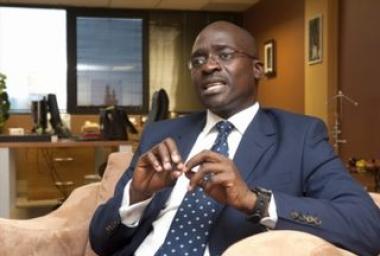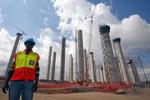SA opting for an evolutionary green-infrastructure transition
 Minister of Public Enterprises Malusi Gigaba.
Minister of Public Enterprises Malusi Gigaba.
The infrastructure backlog has been hampering South Africa’s development over the past few years.
But, in dealing with this challenge, the country also needs to consider ways to build sustainable infra-structure that takes account of the country’s ecosystems and rich biodiversity, the mainte-nance of which could have both job and economic benefits.
But speaking at the recent Development Bank of Southern Africa (DBSA) Knowledge Week, Public Enterprises Minister Malusi Gigaba stressed that the transition to a greener economy would not be without trade-offs, especially in light of the country’s relatively energy-intensive economic reality.
“South Africa is one of the highest greenhouse-gas emitters globally – it is ranked among the top 30,” Gigaba acknowledged. The move towards green infrastructure could only be achieved through a collaborative effort between domestic and international stakeholders, through schemes such as the South African Renewables Initiative (SARi).
He also cautioned that the transition would have to be evolutionary, as a “big bang” approach to overhaul the current make-up of the economy could have serious employment and growth consequences. Therefore, a gradual integrated strategy would be pursued and new technologies phased in over time.
“Technology plays a significant role in moving towards the construction of green infrastructure across industries, such as power and transport, besides others. Hence, there is a call for a knowledge-based economy to be able to achieve a high level of technology integration in the built environment.
“A significant question is: What cost will the move to a green economy have on the country? The answer is not an easy one because the country is currently 70% dependent on coal. We need to ponder what will happen to sectors such as coal once we go green and how we can ensure integration of such industries without losing on future capital investment,” he said.
The foundations were being laid, though, for an open dialogue about the advantages and disadvantages of the transition. This conver- sation would be backed by research.
Greening Pains
National Treasury public finance deputy director-general Andrew Donaldson added that the discussion had to include those actively involved in trade and industrial activity to fully understand whether jobs would be created or lost through the transition.
He noted that government did not directly subscribe to the theory of limits to growth; however, it did realise the importance of sustainable development.
A significant aim was to begin accounting for the environmental costs associated with current production systems – an ‘externality’ that, in most industries, was not typically taken into account.
He acknowledged that companies would probably also require assistance and incentives to make the transition while remaining globally competitive.
“It is proven that environment regulations and standards are currently costly to implement, but they are beneficial in the long run. The transition should be conducted taking into account that, if the regulations are incorrectly implemented, this has the potential to negatively affect the country’s external competitiveness,” said Donaldson.
Construction Industry Development Board programme manager Dr Rodney Milford said regulation and control were significant drivers in building green infrastructure. Currently, regulation, codes and standards were being developed to guide the construction industry in the criteria for greening infrastructure.
Milford also said a green building framework and a monitoring system were being developed; however, both were complex in terms of green infrastructure classification – for example, in defining the infrastructure class of new and existing infrastructure.
Lacking Definition
Consulting Engineers of South Africa member Jonah Ptak said there was a notion among members of the engineering industry that greening infrastructure might not bring competitiveness to industry.
“In reality, the industry does not have set guidelines for greening infrastructure and only relies on the clients’ parameters. The lack of direction and definitions of green elements poses challenges when designing infrastructure, which leads to interpretation challenges,” said Ptak.
He added that, to provide clarity on greening infrastructure, there was a need for set standards and definitions, a system to track and calculate green elements and a report for green infrastructure projects.
Further, National Labour and Economic Development Institute (Naledi) executive director Rudi Dicks said the organisation supported any initiative to curb carbon dioxide emissions and promote green practices. But, through its extensive research, funded by the World Wide Fund for Nature, into the possibility of a green economy, it had established that the poor and vulnerable of society would be negatively affected.
“The main question on labour’s side is: What will happen to the significant number of labourers that are employed in the mining industry, when we move towards the green economy?” he asked.
Dicks said Naledi did not dispute the move to a green economy, which would support the development of green infrastructure on a larger scale, but it wanted to find out what the plan was to avoid job losses in this transition.
He said Naledi was canvassing for a “just transition”, which was the investment in environment-friendly activities that created decent jobs that met health and safety standards, promoted gender equality and secured comprehensive social protection for the most vulnerable citizens.
“This should also include skills development and retraining workers to ensure they can be part of the new low-carbon economy develop- ment model. A twofold energy strategy is required to reduce the dependence on fossil fuels and, simultaneously, for rapid expansion of household access to electricity,” said Dicks.
Policy & Monitoring
Department of Performance Monitoring and Evaluation planning and coordination chief director Judy Beaumont acknowledged that, among the significant challenges facing government in building green infrastructure was the lack of policy alignment and a requisite monitoring system.
“The key consideration is how to plan and manage the transition to a greener growth path in a manner that also creates job opportunities, promotes economic growth and reduces poverty. The transition requires prioritisation, categorisation of the type of actions that are possible, long-term and short-term sequencing, and path dependencies such as a policy framework before the action programme can be taken into account.
“We need to also select catalysts with multiple outcomes, such as using criteria, for example, for employment creation, local industry development, enhancing competitiveness, building on what exists and enhancing natural capital,” said Beaufort.
Lessons to Ponder
The University of the Witwatersrand’s Professor William Gumede emphasised that, to deal with the infrastructure backlog and the move towards building green infrastructure, government needed to have a rigorous long-term infrastructure planning system in place that incorporated economic growth.
“How does government expect to achieve long-term integrated infrastructure planning without a long-term infrastructure development plan,” he asked.
Gumede noted that technical capacity also played a significant role in greening infrastructure – hence, the need to also prioritise skills development.
The Infrastructure Inputs Monitoring Project’s Dr Zavareh Rustomjee said factors impacting on infrastructure demand included a lack of generic capacity from municipalities and at provincial level for project preparation, understanding the tendering process and project execution, as these required infrastructure demand forecasting accuracy.
Challenges facing the development of a green infrastructure industry included the impact of rising energy costs on energy-intensive supply sectors, such as steel, aluminium, cement, glass and bricks.
“Energy efficiency and climate change issues also hamper the growth of the green infrastructure industry – for example, nuclear versus coal, renewable generation tech- nologies, tighter fuel specifications, building regulations, environment regulation, and cement and brick production technology,” said Rustomjee.
Enthusiasts
However, SARi is optimistic about the possibility of a green economy and argues that, globally, renewable-energy programmes are supported by industrial policies, as well as clean energy aims.
SARi’s aim is to develop a finance strategy for the development of renewable-energy generation by developing a green economy strategy. This would be achieved through energy planning initiatives, power purchase agreements and a climate change policy, said the Department of Public Enterprises strategic projects adviser Dr Edwin Ritchken.
He said SARi aimed to reduce the cost of capital for renewables by diversifying the sources of funding for renewable-energy projects. Funding options included fiscal contribution, international funding or pay-for-performance climate-related grant funding and green energy purchase obligations.
“The renewable-energy industry has the potential to create 40 000 to 45 000 jobs for skilled and semiskilled employees between 2020 and 2045.”
Funding Model
DBSA Investment Banking Division executive Lucy Chege said the bank not only played a financing role for greening infrastructure but it was also an agent for change.
“To ensure sufficient funding capacity for green industries, there is a need to increase the lending capacity and loan security require- ments. Currently, there are limitations to funding green infrastructure projects, owing to the different stages of risk and obligation they pose,” said Chege.
She said there was a call for greening infra- structure guidelines for some of the major sectors in the country to provide a step-by-step how-to guide of what was expected.
The DBSA prided itself on also providing funding for green industry projects on a smaller scale for small and medium-sized business enterprises.
“As a middle-income economy, South Africa can create a high-risk scenario if it only depends on international funding for green infrastructure projects,” she said.
The Industrial Development Corporation has set aside R25-billion for investments towards the move to a green economy, while the DBSA is in the process of setting up green economy mechanisms to assist in funding investments in green industries.
Looking into the Future
In the event closing address, Minister of Environmental Affairs Edna Molewa said there was a call to increase investment in green economy industries for job creation by pro-moting green cities through the sustainable and integrated planning of infrastructure and service delivery. This way, the country would be able to contribute to increased efficiency and production.
“Spatial planning and land use management are significant determinants for the sustainability of the built environment. For the built environment to serve as an effective habitat for human beings, it must be designed, constructed, managed and used in a manner that natural elements, such as air, water, soil and biodiversity that sustain human life, are preserved.
“This entails the design of the built environment, which is characterised by urban greening, biodiversity conservation and enhancement, effective waste management services with greater levels of recycling and green public transportation, including the prevalence of nonmotorised transportation infrastructure,” added Molewa.
In partnership with the DBSA, the Department of Environmental Affairs (DEA) has developed the The Green Financing Mechanism as a platform to attract, manage and direct international and national financing for transitioning South Africa from research and development to investing in green economy initiatives.
South African National Biodiversity Institute CEO Dr Tanya Abrahamse said biodiversity and ecosystems provided a foundation for resilience and climate proofing. There was a need to secure recognition of ecological infra-structure improvement and maintenance to support the move to a green economy.
Meanwhile, South African Bureau of Standards executive Dr Sadhvir Bissoon said developing set standards for the green industry would ensure that efficiency measures were more reliable and competitive in green infrastructure management and public administration.
Donaldson highlighted developments that had contributed, or would contribute, to a knowledge-sharing platform for green economy, including the National Planning Commission’s growth diagnostic document, the Department of Economic Development’s New Growth Path, the Department of Trade and Industry’s Industrial Policy Action Plan, the Department of Mineral Resources’ Beneficiation Strategy, the DEA’s National Climate Change Response Strategy and South Africa’s hosting of the seventeenth Conference of the Parties climate conference later this year.
All stakeholders involved in the greening infrastructure discussions have a common understanding of how the lack of regulation is negatively affecting progress. However, government has emphasised that it will not act in haste to finalise policies and needs a con- siderable amount of time to ensure that the right policies are implemented.

















